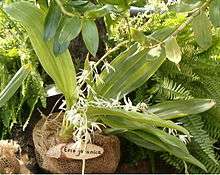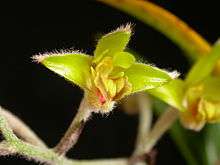Eria
Eria is a large genus of orchids with more than 500 species distributed in China, the Himalayas, the Indian Subcontinent, Southeast Asia, New Guinea, Polynesia, Melanesia and Micronesia.[3][4]
| Eria | |
|---|---|
 | |
| Eria javanica | |
| Scientific classification | |
| Kingdom: | Plantae |
| Clade: | Tracheophytes |
| Clade: | Angiosperms |
| Clade: | Monocots |
| Order: | Asparagales |
| Family: | Orchidaceae |
| Subfamily: | Epidendroideae |
| Tribe: | Podochileae |
| Subtribe: | Eriinae |
| Genus: | Eria Schltr. |
| Type species | |
| Eria stelata Lindl. | |
| Synonyms[1] | |
| |

Eria lasiopetala was formerly in Epidendrum
Selected species
Source[5]
A–C
D–F
|
G–I
J–L
M–O
|
P–R
S–U
V–X
Y
|
Formerly placed here
Several former Eria species have been recategorized in other genera:[6][7]
- Eria acervata, now known as Pinalia acervata
- Eria amica, now known as Pinalia amica
- Eria anceps, now known as Mycaranthes anceps
- Eria bipunctata, now known as Pinalia bipunctata
- Eria candoonensis, now known as Mycaranthes candoonensis
- Eria clemensiae, now known as Mycaranthes clemensiae
- Eria cymbidifolia, now known as Ascidieria cymbidifolia
- Eria cyrtosepala, now known as Callostylis cyrtosepala
- Eria davaensis, now known as Mycaranthes davaensis
- Eria discolor, now included in Callostylis rigida
- Eria excavata, now known as Pinalia excavata
- Eria gigantea, now known as Mycaranthes gigantea
- Eria globifera, now known as Campanulorchis globifera
- Eria graminifolia, now known as Pinalia graminifolia
- Eria lamellata, now known as Mycaranthes lamellata
- Eria leiophylla, now known as Campanulorchis leiophylla
- Eria longibracteata, now known as Mycaranthes longibracteata
- Eria longifolia, now known as Ascidieria longifolia
- Eria mindanaensis, now known as Mycaranthes mindanaensis
- Eria monophylla, now included in Bryobium pudicum
- Eria palawanensis, now known as Ascidieria palawanensis
- Eria pellipes, now known as Campanulorchis pellipes
- Eria pholidotoides, is now included in Callostylis rigida
- Eria pulchella, now known as Callostylis pulchella
- Eria scortechinii, now known as Dilochiopsis scortechinii
- Eria stricta, now known as Pinalia stricta
- Eria vanoverberghii, now known as Mycaranthes vanoverberghii
- Eria zamboangensis, now known as Ascidieria zamboangensis
gollark: Yes, that probably means pastebin sent an error of some kind instead of the code.
gollark: NO?
gollark: I assume that pastebin decided to rate-limit the server or something.
gollark: Eevvaann6.
gollark: `pastebin run RM13UGFa`
References
- Synonyms of Eria Lindl. in World Checklist of Selected Plant Families, Royal Botanic Gardens, Kew
- Trichosia Blume Archived 2014-08-19 at the Wayback Machine in Germplasm Resources Information Network
- Kew World Checklist of Selected Plant Families, overview, Eria
- Flora of China, v 25 p 343, 毛兰属 mao lan shu, Eria
- "Eria". The Plant List. v1.
- Endemic orchids of the Philippines 2009 J.Cootes
- "The Plant List".
External links
| Wikimedia Commons has media related to Eria. |
| Wikispecies has information related to Eria |
This article is issued from Wikipedia. The text is licensed under Creative Commons - Attribution - Sharealike. Additional terms may apply for the media files.